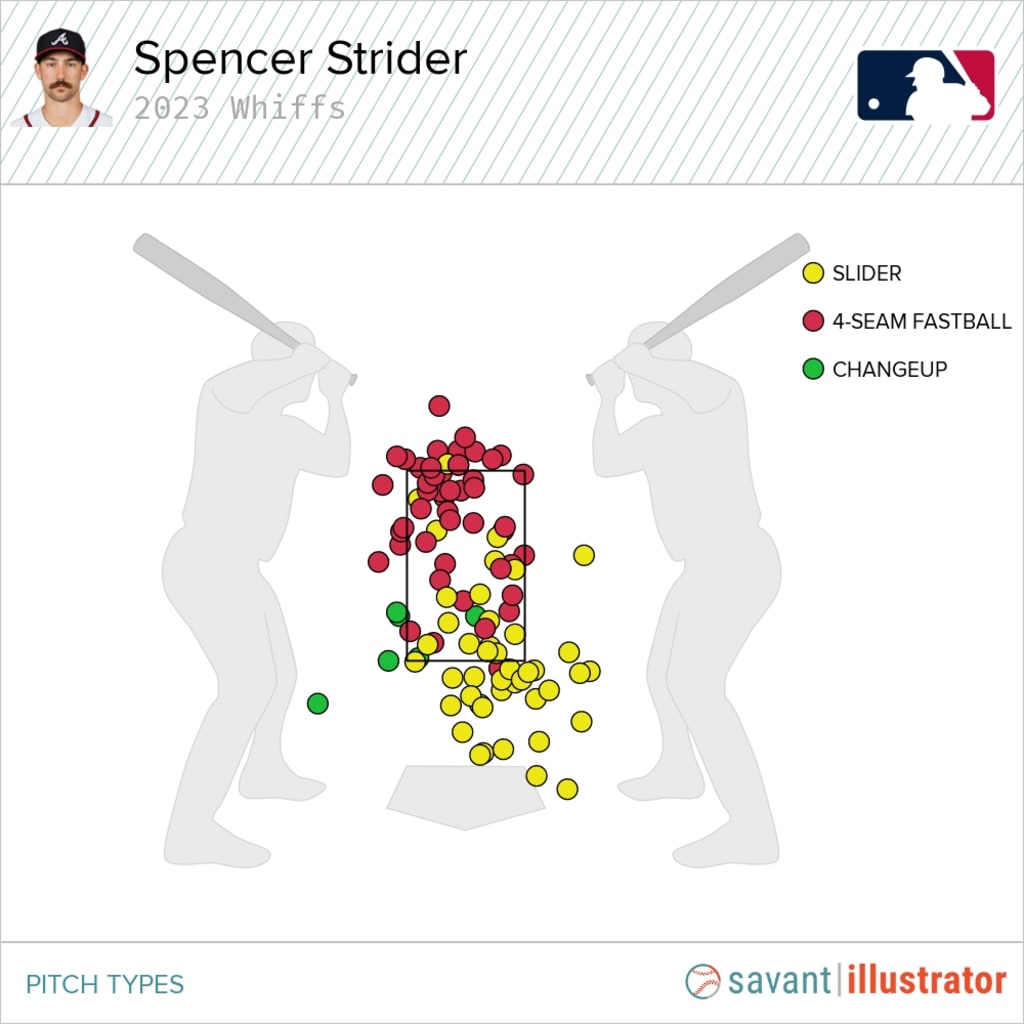Shortly after Spencer Strider nearly no-hit the Marlins on April 24, Miami manager Skip Schumaker said, “It felt like you were facing the closer there for eight innings.”
That statement accurately summarizes Strider, whose breathtaking ascent over the past year has made him one of the best starting pitchers in the Majors. After a superb rookie season in 2022, Strider’s scorching-hot start to this season has only cemented his lofty place among the game’s aces.
Through his first five starts of the 2023 season, Strider has a 1.80 ERA in 30 innings and has struck out 49 of the 115 hitters he has faced. His upper-90s fastball and wipeout slider have produced some of the gaudiest swing-and-miss numbers we’ve seen from a starting pitcher.
With Strider set to face the Mets in Game 1 of Monday's doubleheader, let’s take a look at where the righty stands after 25 career starts -- both against his peers and historically -- and explain how he made such a quick jump into the upper echelon.
A rapid climb to the top
Strider actually began to rocket to prominence in 2021, when he excelled at four Minor League levels and even reached the Majors for a short late-season stint. A pitcher whose collegiate career at Clemson was limited by Tommy John surgery and the COVID shutdown went from the Braves’ 24th-ranked prospect, per MLB Pipeline, all the way up to second entering '22.
When Strider made the Braves’ 2022 Opening Day roster, he began in the bullpen, but it was clear that Atlanta was gearing up for him to be a starter. After he dominated in that role, Atlanta made the decision to move him into the rotation in late May, and both the Braves and Strider have not looked back since then.
From May 30 through the end of the season, Strider posted a 2.77 ERA across 20 starts. Among the 79 pitchers with at least 100 innings in that timeframe, he finished in the top five in WAR (4.2), strikeouts (165) and FIP (1.92). Strider became the fastest pitcher in AL/NL history to reach 200 strikeouts and finished runner-up in National League Rookie of the Year Award voting to teammate Michael Harris II.
If there was any doubt about the legitimacy of Strider’s 2022 season, his start to the ‘23 campaign should quash those concerns. When looking back to his first MLB start last May, Strider is either at the top or near it in practically every meaningful measure for starting pitchers.
Strider’s ranks among SP since May 30, 2022
Minimum 100 innings
Making history
It is not hyperbole to say that Strider is off to one of the best starts by a starting pitcher in MLB history.
According to the Elias Sports Bureau, Strider has held opposing hitters to the worst triple slash line (BA/OBP/SLG) by any starting pitcher through their first 25 MLB starts in the Expansion Era (since 1961).
Strider's ranks through first 25 MLB starts
Since 1961, minimum 100 innings
- 1st in BA (.172, best since 1920)
- 1st in OBP (.246)
- 4th in SLG (.256)
- 1st in OPS (.502)
Strider isn't just hard to do damage against; he's hard to make contact against. Strider has struck out 214 hitters through his first 25 MLB starts. That is the third-most strikeouts by any starting pitcher through 25 starts since 1893, the year the mound was moved to its current 60-foot, 6-inch distance.
Most strikeouts through first 25 MLB starts
Since 1893
Kerry Wood (CHC): 223
Hideo Nomo (LAD): 220
Spencer Strider (ATL): 214
Topping 2022
Strider was so dominant as a starting pitcher in 2022 that it was maybe fair to expect some regression in ‘23. Well, all he’s done is repeat that performance -- or even pitch better according to several measures.
Strider’s 2022 vs. ‘23 stats (as a SP)
- 2.77 ERA vs. 1.88 ERA
- 1.92 FIP vs. 1.70 FIP
- 38.1 K% vs. 42.6 K%
- 28.5 whiff% vs. 40.1 whiff%
- .182 BA vs. .136 BA
- .175 xBA vs. .175 xBA
- .274 SLG vs. .184 SLG
- .269 xSLG vs. .266 xSLG
The most notable improvement is Strider’s 11.6% increase on an already-elite whiff rate. Just to reiterate, Strider is generating whiffs (swinging strikes) on 40.1% of the swings against him this year. That’s a level typically achieved only by elite relievers. Jacob deGrom and Shane Bieber are the only starters to post a 40% whiff rate in the pitch-tracking era (since 2008), and neither did it while throwing 100-plus innings.
What’s sparking the uptick in whiffs? It’s almost certainly tied to better command. Strider hovered right around league average in several command indicators in 2022. While his walks are up a bit this year (+1.1%), he’s made some of the biggest year-to-year command improvements that have propelled him to an even higher level.
Strider’s ranks in 2022-23 command improvements
Among 243 qualifying pitchers
- 7th-largest jump in zone rate (7.3%)
- 6th-largest jump in edge rate (5.6%)
- 27th-largest jump in first-pitch strike rate (7.6%)
Among the 135 pitchers who have faced at least 75 batters in 2023, Strider ranks tied for second in zone rate (58.4%), 10th in edge rate (47.4%) and is tied for 18th in first-pitch strike rate (67.8%), meaning he is not only hitting the zone but working the edges of the zone and getting ahead of batters. It turns out that pairing elite top-shelf stuff with really good command leads to impossibly good results.
Refining a weapon
Additionally, Strider is throwing a bit of a different slider this year. The pitch was dominant in 2022 and is great once again in ‘23 but the shape of the pitch might be helping his entire profile play up. Strider has swapped about 2 mph on the slider for an additional 3 inches of drop.
With nearly 40 inches of drop but very little horizontal break, Strider’s improved slider only helps his explosive fastball. Why? Strider’s fastball excels up in the zone because it has both elite velocity and rise, making it nearly impossible to do anything against. With the additional break on his already-great slider, he's creating even more separation between his elevated fastballs and sliders buried down or below the zone.
You can see this in his pitch chart that shows all of the whiffs he's induced on his fastball and slider (along with a few changeups) in 2023.

This isn't exactly rocket science, but Strider putting himself ahead in the count more often is allowing his elite stuff to generate better results. More first-pitch strikes and pitches on the edge of the zone have given opposing hitters even fewer chances to try to make contact against Strider. When Strider has gotten ahead in the count this year, hitters have hit a measly .121/.136/.138 against him and generated just one extra-base hit (a double).
While it’s still early, there are several indicators that Strider could be going to an even higher level this season. If the improved command sticks and he keeps getting this type of drop on his slider, we might be talking about Strider winning the NL Cy Young Award by the end of the season.
